Mathematical Proofs: Advantages and Disadvantages of Computer Checks
VerifiedAdded on 2020/04/15
|9
|2334
|74
Essay
AI Summary
This essay delves into the core concepts of mathematical proofs, exploring their definition, historical context, and significance in the field of mathematics. It highlights the evolution of proofs, tracing their roots back to axioms and inference rules. The essay then examines the role of computer verification in modern mathematical proofs, discussing the development of computer-checked proofs and the use of specialized software. It analyzes the benefits and drawbacks of relying on computers to validate complex mathematical theorems, addressing concerns about potential errors and the limitations of current proof-checking programs. Furthermore, it provides examples of computer-assisted proofs, like the Four Color Theorem and Kepler Conjecture, and discusses the future of computer-based proof systems. The essay concludes by emphasizing the need for critical evaluation and the importance of addressing the observed failures in current systems to enhance the precision and dependability of computer-checked mathematical proofs.
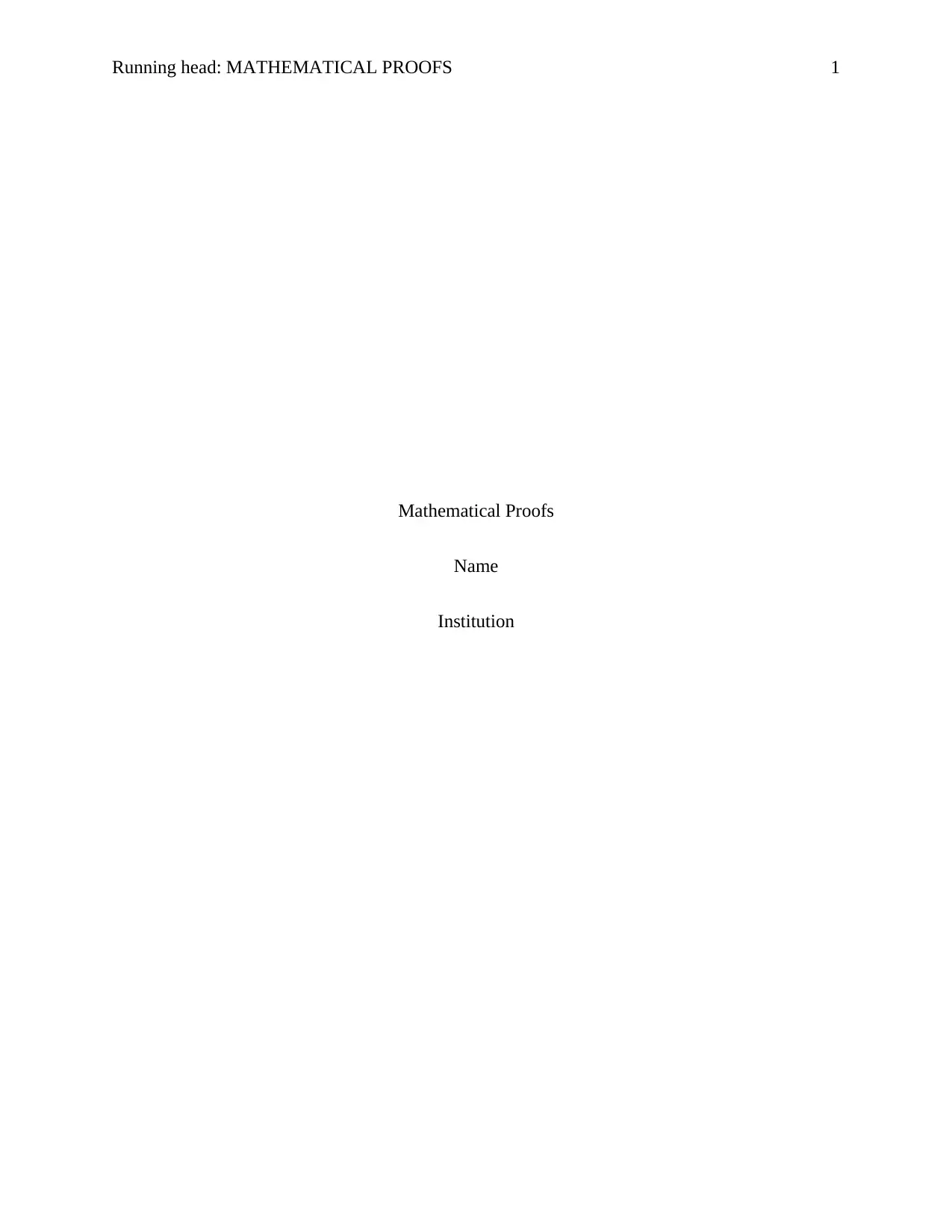
Running head: MATHEMATICAL PROOFS 1
Mathematical Proofs
Name
Institution
Mathematical Proofs
Name
Institution
Paraphrase This Document
Need a fresh take? Get an instant paraphrase of this document with our AI Paraphraser
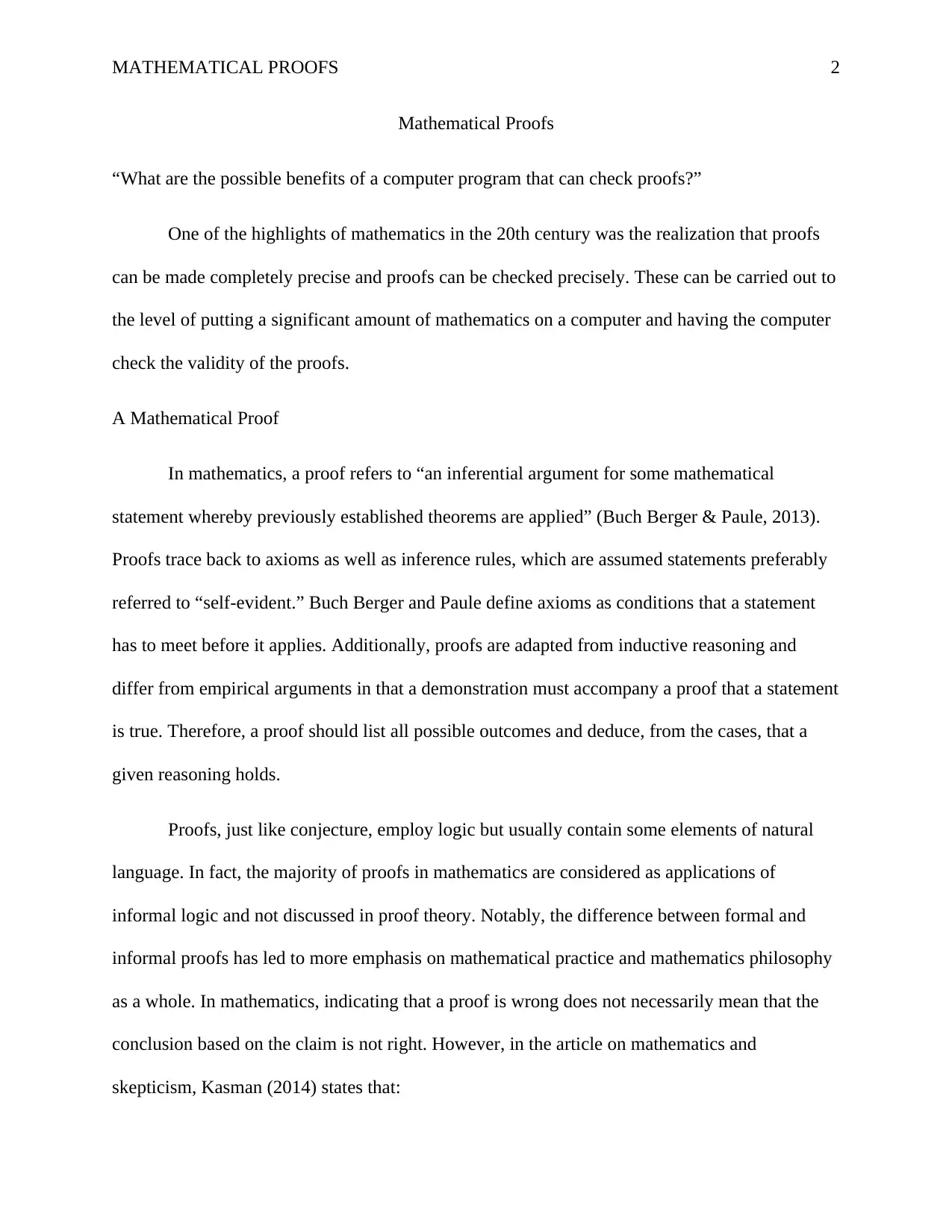
MATHEMATICAL PROOFS 2
Mathematical Proofs
“What are the possible benefits of a computer program that can check proofs?”
One of the highlights of mathematics in the 20th century was the realization that proofs
can be made completely precise and proofs can be checked precisely. These can be carried out to
the level of putting a significant amount of mathematics on a computer and having the computer
check the validity of the proofs.
A Mathematical Proof
In mathematics, a proof refers to “an inferential argument for some mathematical
statement whereby previously established theorems are applied” (Buch Berger & Paule, 2013).
Proofs trace back to axioms as well as inference rules, which are assumed statements preferably
referred to “self-evident.” Buch Berger and Paule define axioms as conditions that a statement
has to meet before it applies. Additionally, proofs are adapted from inductive reasoning and
differ from empirical arguments in that a demonstration must accompany a proof that a statement
is true. Therefore, a proof should list all possible outcomes and deduce, from the cases, that a
given reasoning holds.
Proofs, just like conjecture, employ logic but usually contain some elements of natural
language. In fact, the majority of proofs in mathematics are considered as applications of
informal logic and not discussed in proof theory. Notably, the difference between formal and
informal proofs has led to more emphasis on mathematical practice and mathematics philosophy
as a whole. In mathematics, indicating that a proof is wrong does not necessarily mean that the
conclusion based on the claim is not right. However, in the article on mathematics and
skepticism, Kasman (2014) states that:
Mathematical Proofs
“What are the possible benefits of a computer program that can check proofs?”
One of the highlights of mathematics in the 20th century was the realization that proofs
can be made completely precise and proofs can be checked precisely. These can be carried out to
the level of putting a significant amount of mathematics on a computer and having the computer
check the validity of the proofs.
A Mathematical Proof
In mathematics, a proof refers to “an inferential argument for some mathematical
statement whereby previously established theorems are applied” (Buch Berger & Paule, 2013).
Proofs trace back to axioms as well as inference rules, which are assumed statements preferably
referred to “self-evident.” Buch Berger and Paule define axioms as conditions that a statement
has to meet before it applies. Additionally, proofs are adapted from inductive reasoning and
differ from empirical arguments in that a demonstration must accompany a proof that a statement
is true. Therefore, a proof should list all possible outcomes and deduce, from the cases, that a
given reasoning holds.
Proofs, just like conjecture, employ logic but usually contain some elements of natural
language. In fact, the majority of proofs in mathematics are considered as applications of
informal logic and not discussed in proof theory. Notably, the difference between formal and
informal proofs has led to more emphasis on mathematical practice and mathematics philosophy
as a whole. In mathematics, indicating that a proof is wrong does not necessarily mean that the
conclusion based on the claim is not right. However, in the article on mathematics and
skepticism, Kasman (2014) states that:
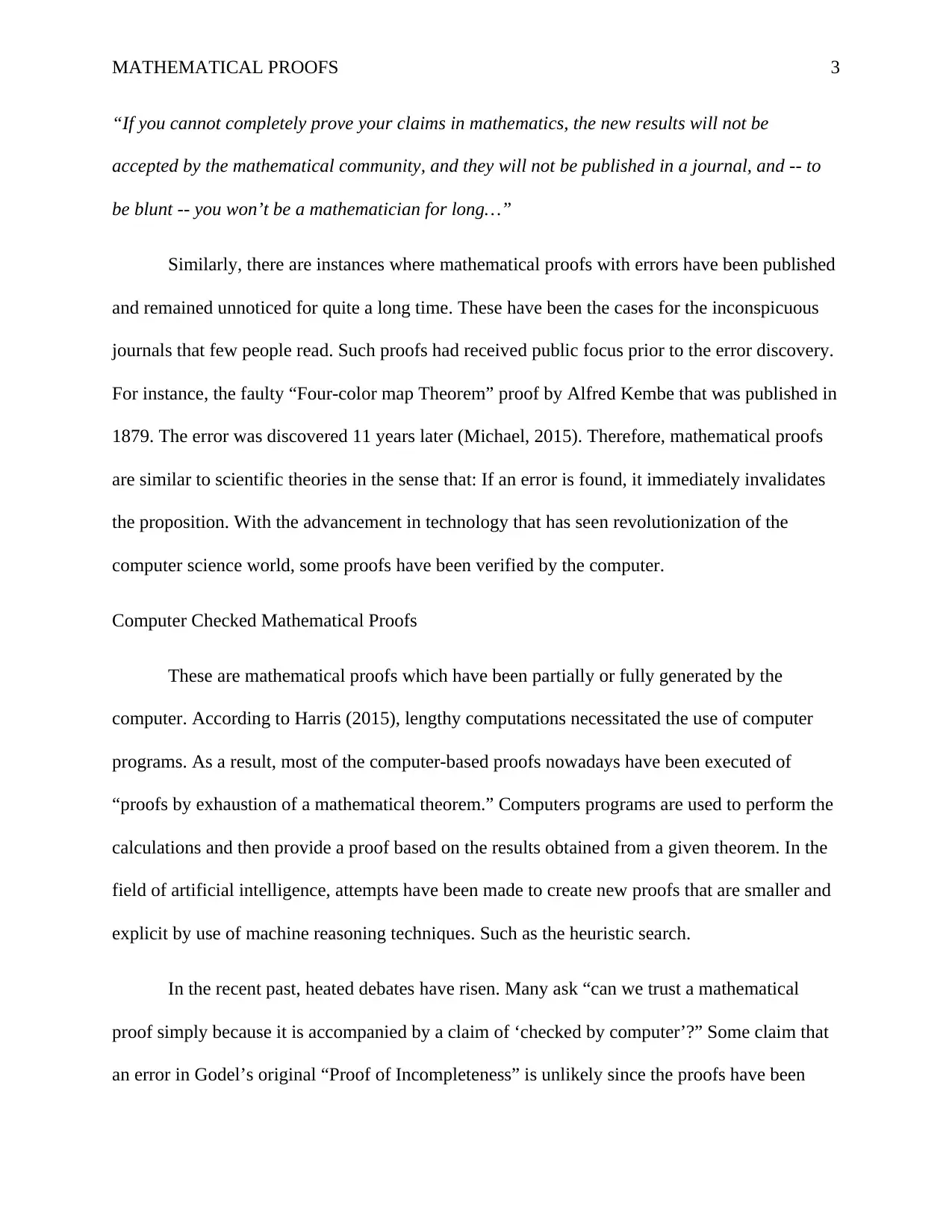
MATHEMATICAL PROOFS 3
“If you cannot completely prove your claims in mathematics, the new results will not be
accepted by the mathematical community, and they will not be published in a journal, and -- to
be blunt -- you won’t be a mathematician for long…”
Similarly, there are instances where mathematical proofs with errors have been published
and remained unnoticed for quite a long time. These have been the cases for the inconspicuous
journals that few people read. Such proofs had received public focus prior to the error discovery.
For instance, the faulty “Four-color map Theorem” proof by Alfred Kembe that was published in
1879. The error was discovered 11 years later (Michael, 2015). Therefore, mathematical proofs
are similar to scientific theories in the sense that: If an error is found, it immediately invalidates
the proposition. With the advancement in technology that has seen revolutionization of the
computer science world, some proofs have been verified by the computer.
Computer Checked Mathematical Proofs
These are mathematical proofs which have been partially or fully generated by the
computer. According to Harris (2015), lengthy computations necessitated the use of computer
programs. As a result, most of the computer-based proofs nowadays have been executed of
“proofs by exhaustion of a mathematical theorem.” Computers programs are used to perform the
calculations and then provide a proof based on the results obtained from a given theorem. In the
field of artificial intelligence, attempts have been made to create new proofs that are smaller and
explicit by use of machine reasoning techniques. Such as the heuristic search.
In the recent past, heated debates have risen. Many ask “can we trust a mathematical
proof simply because it is accompanied by a claim of ‘checked by computer’?” Some claim that
an error in Godel’s original “Proof of Incompleteness” is unlikely since the proofs have been
“If you cannot completely prove your claims in mathematics, the new results will not be
accepted by the mathematical community, and they will not be published in a journal, and -- to
be blunt -- you won’t be a mathematician for long…”
Similarly, there are instances where mathematical proofs with errors have been published
and remained unnoticed for quite a long time. These have been the cases for the inconspicuous
journals that few people read. Such proofs had received public focus prior to the error discovery.
For instance, the faulty “Four-color map Theorem” proof by Alfred Kembe that was published in
1879. The error was discovered 11 years later (Michael, 2015). Therefore, mathematical proofs
are similar to scientific theories in the sense that: If an error is found, it immediately invalidates
the proposition. With the advancement in technology that has seen revolutionization of the
computer science world, some proofs have been verified by the computer.
Computer Checked Mathematical Proofs
These are mathematical proofs which have been partially or fully generated by the
computer. According to Harris (2015), lengthy computations necessitated the use of computer
programs. As a result, most of the computer-based proofs nowadays have been executed of
“proofs by exhaustion of a mathematical theorem.” Computers programs are used to perform the
calculations and then provide a proof based on the results obtained from a given theorem. In the
field of artificial intelligence, attempts have been made to create new proofs that are smaller and
explicit by use of machine reasoning techniques. Such as the heuristic search.
In the recent past, heated debates have risen. Many ask “can we trust a mathematical
proof simply because it is accompanied by a claim of ‘checked by computer’?” Some claim that
an error in Godel’s original “Proof of Incompleteness” is unlikely since the proofs have been
⊘ This is a preview!⊘
Do you want full access?
Subscribe today to unlock all pages.

Trusted by 1+ million students worldwide
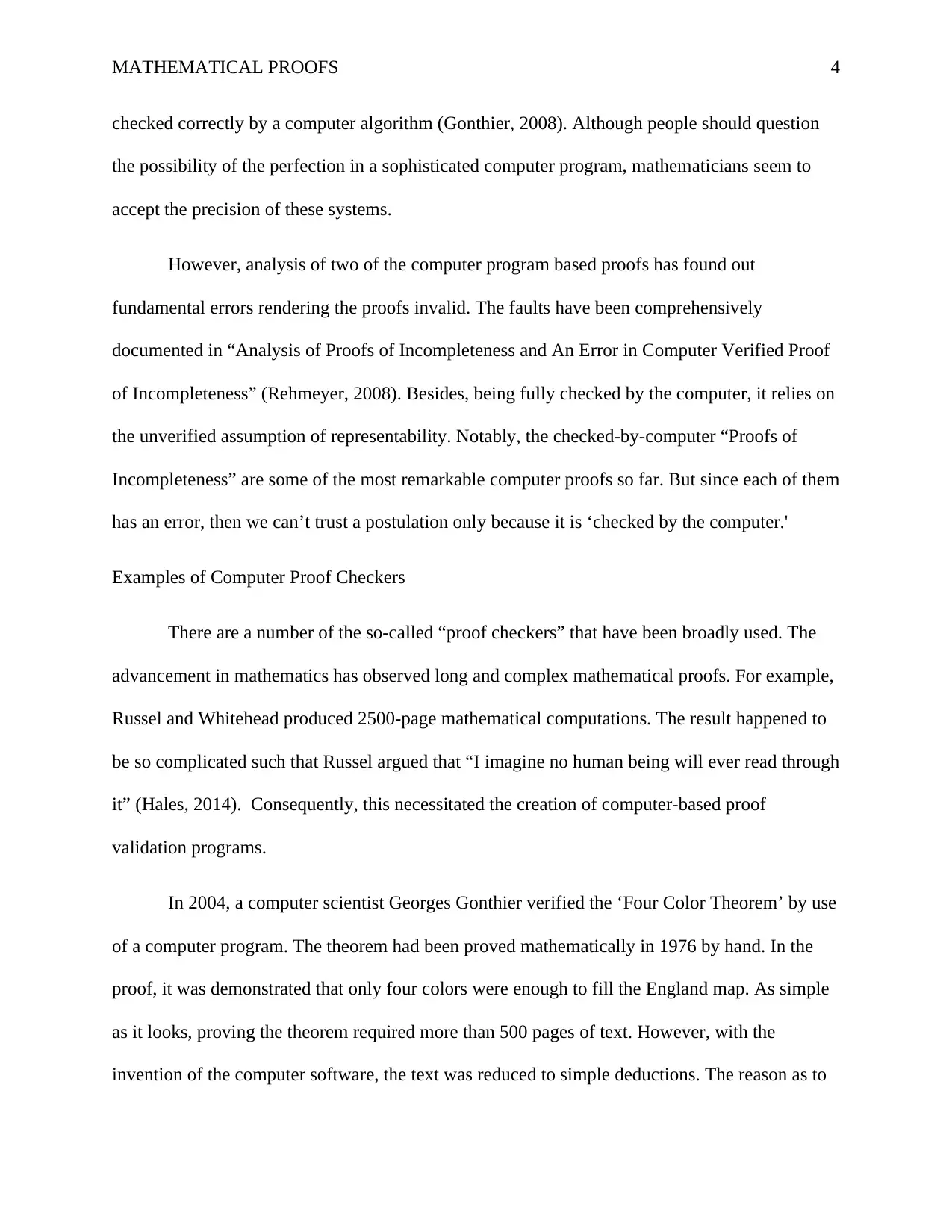
MATHEMATICAL PROOFS 4
checked correctly by a computer algorithm (Gonthier, 2008). Although people should question
the possibility of the perfection in a sophisticated computer program, mathematicians seem to
accept the precision of these systems.
However, analysis of two of the computer program based proofs has found out
fundamental errors rendering the proofs invalid. The faults have been comprehensively
documented in “Analysis of Proofs of Incompleteness and An Error in Computer Verified Proof
of Incompleteness” (Rehmeyer, 2008). Besides, being fully checked by the computer, it relies on
the unverified assumption of representability. Notably, the checked-by-computer “Proofs of
Incompleteness” are some of the most remarkable computer proofs so far. But since each of them
has an error, then we can’t trust a postulation only because it is ‘checked by the computer.'
Examples of Computer Proof Checkers
There are a number of the so-called “proof checkers” that have been broadly used. The
advancement in mathematics has observed long and complex mathematical proofs. For example,
Russel and Whitehead produced 2500-page mathematical computations. The result happened to
be so complicated such that Russel argued that “I imagine no human being will ever read through
it” (Hales, 2014). Consequently, this necessitated the creation of computer-based proof
validation programs.
In 2004, a computer scientist Georges Gonthier verified the ‘Four Color Theorem’ by use
of a computer program. The theorem had been proved mathematically in 1976 by hand. In the
proof, it was demonstrated that only four colors were enough to fill the England map. As simple
as it looks, proving the theorem required more than 500 pages of text. However, with the
invention of the computer software, the text was reduced to simple deductions. The reason as to
checked correctly by a computer algorithm (Gonthier, 2008). Although people should question
the possibility of the perfection in a sophisticated computer program, mathematicians seem to
accept the precision of these systems.
However, analysis of two of the computer program based proofs has found out
fundamental errors rendering the proofs invalid. The faults have been comprehensively
documented in “Analysis of Proofs of Incompleteness and An Error in Computer Verified Proof
of Incompleteness” (Rehmeyer, 2008). Besides, being fully checked by the computer, it relies on
the unverified assumption of representability. Notably, the checked-by-computer “Proofs of
Incompleteness” are some of the most remarkable computer proofs so far. But since each of them
has an error, then we can’t trust a postulation only because it is ‘checked by the computer.'
Examples of Computer Proof Checkers
There are a number of the so-called “proof checkers” that have been broadly used. The
advancement in mathematics has observed long and complex mathematical proofs. For example,
Russel and Whitehead produced 2500-page mathematical computations. The result happened to
be so complicated such that Russel argued that “I imagine no human being will ever read through
it” (Hales, 2014). Consequently, this necessitated the creation of computer-based proof
validation programs.
In 2004, a computer scientist Georges Gonthier verified the ‘Four Color Theorem’ by use
of a computer program. The theorem had been proved mathematically in 1976 by hand. In the
proof, it was demonstrated that only four colors were enough to fill the England map. As simple
as it looks, proving the theorem required more than 500 pages of text. However, with the
invention of the computer software, the text was reduced to simple deductions. The reason as to
Paraphrase This Document
Need a fresh take? Get an instant paraphrase of this document with our AI Paraphraser
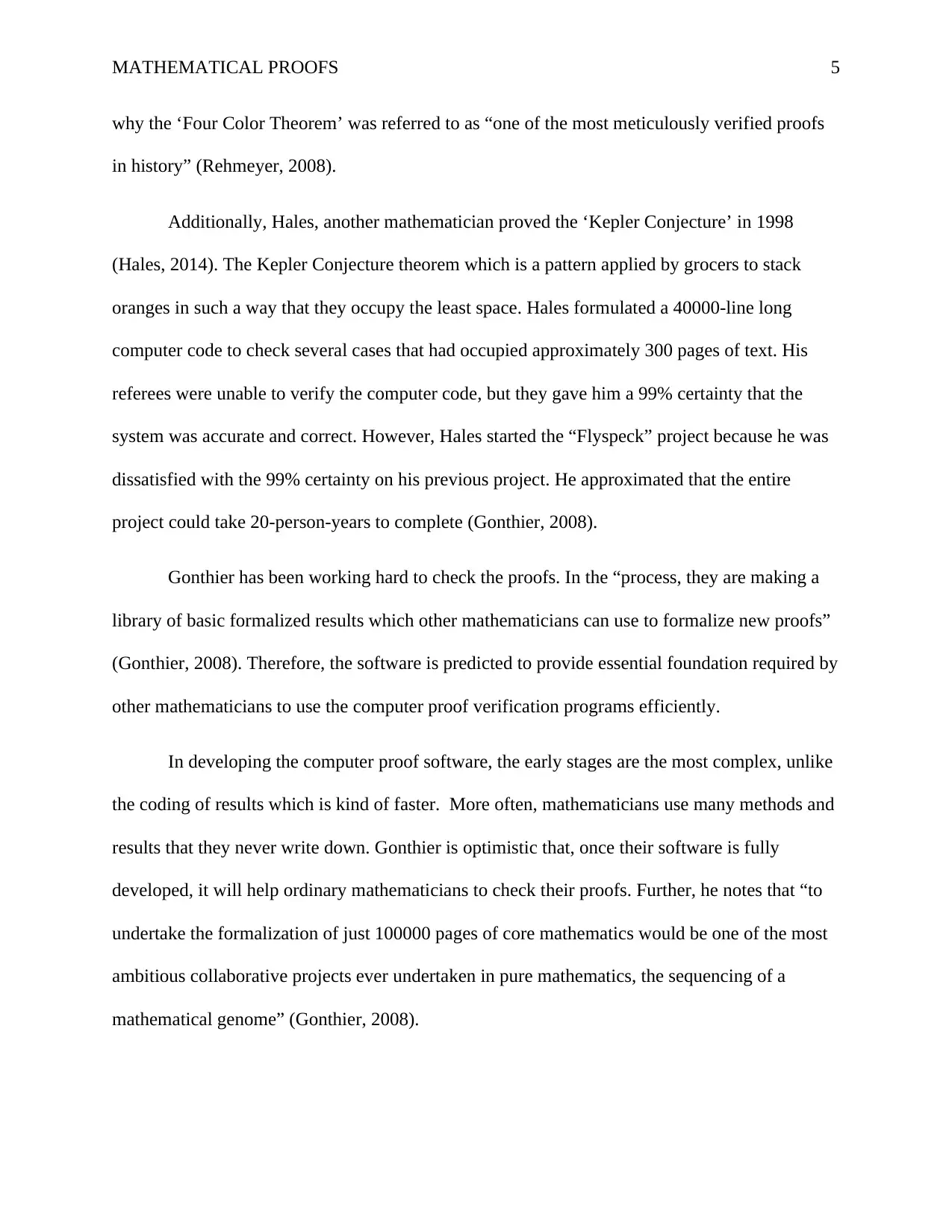
MATHEMATICAL PROOFS 5
why the ‘Four Color Theorem’ was referred to as “one of the most meticulously verified proofs
in history” (Rehmeyer, 2008).
Additionally, Hales, another mathematician proved the ‘Kepler Conjecture’ in 1998
(Hales, 2014). The Kepler Conjecture theorem which is a pattern applied by grocers to stack
oranges in such a way that they occupy the least space. Hales formulated a 40000-line long
computer code to check several cases that had occupied approximately 300 pages of text. His
referees were unable to verify the computer code, but they gave him a 99% certainty that the
system was accurate and correct. However, Hales started the “Flyspeck” project because he was
dissatisfied with the 99% certainty on his previous project. He approximated that the entire
project could take 20-person-years to complete (Gonthier, 2008).
Gonthier has been working hard to check the proofs. In the “process, they are making a
library of basic formalized results which other mathematicians can use to formalize new proofs”
(Gonthier, 2008). Therefore, the software is predicted to provide essential foundation required by
other mathematicians to use the computer proof verification programs efficiently.
In developing the computer proof software, the early stages are the most complex, unlike
the coding of results which is kind of faster. More often, mathematicians use many methods and
results that they never write down. Gonthier is optimistic that, once their software is fully
developed, it will help ordinary mathematicians to check their proofs. Further, he notes that “to
undertake the formalization of just 100000 pages of core mathematics would be one of the most
ambitious collaborative projects ever undertaken in pure mathematics, the sequencing of a
mathematical genome” (Gonthier, 2008).
why the ‘Four Color Theorem’ was referred to as “one of the most meticulously verified proofs
in history” (Rehmeyer, 2008).
Additionally, Hales, another mathematician proved the ‘Kepler Conjecture’ in 1998
(Hales, 2014). The Kepler Conjecture theorem which is a pattern applied by grocers to stack
oranges in such a way that they occupy the least space. Hales formulated a 40000-line long
computer code to check several cases that had occupied approximately 300 pages of text. His
referees were unable to verify the computer code, but they gave him a 99% certainty that the
system was accurate and correct. However, Hales started the “Flyspeck” project because he was
dissatisfied with the 99% certainty on his previous project. He approximated that the entire
project could take 20-person-years to complete (Gonthier, 2008).
Gonthier has been working hard to check the proofs. In the “process, they are making a
library of basic formalized results which other mathematicians can use to formalize new proofs”
(Gonthier, 2008). Therefore, the software is predicted to provide essential foundation required by
other mathematicians to use the computer proof verification programs efficiently.
In developing the computer proof software, the early stages are the most complex, unlike
the coding of results which is kind of faster. More often, mathematicians use many methods and
results that they never write down. Gonthier is optimistic that, once their software is fully
developed, it will help ordinary mathematicians to check their proofs. Further, he notes that “to
undertake the formalization of just 100000 pages of core mathematics would be one of the most
ambitious collaborative projects ever undertaken in pure mathematics, the sequencing of a
mathematical genome” (Gonthier, 2008).
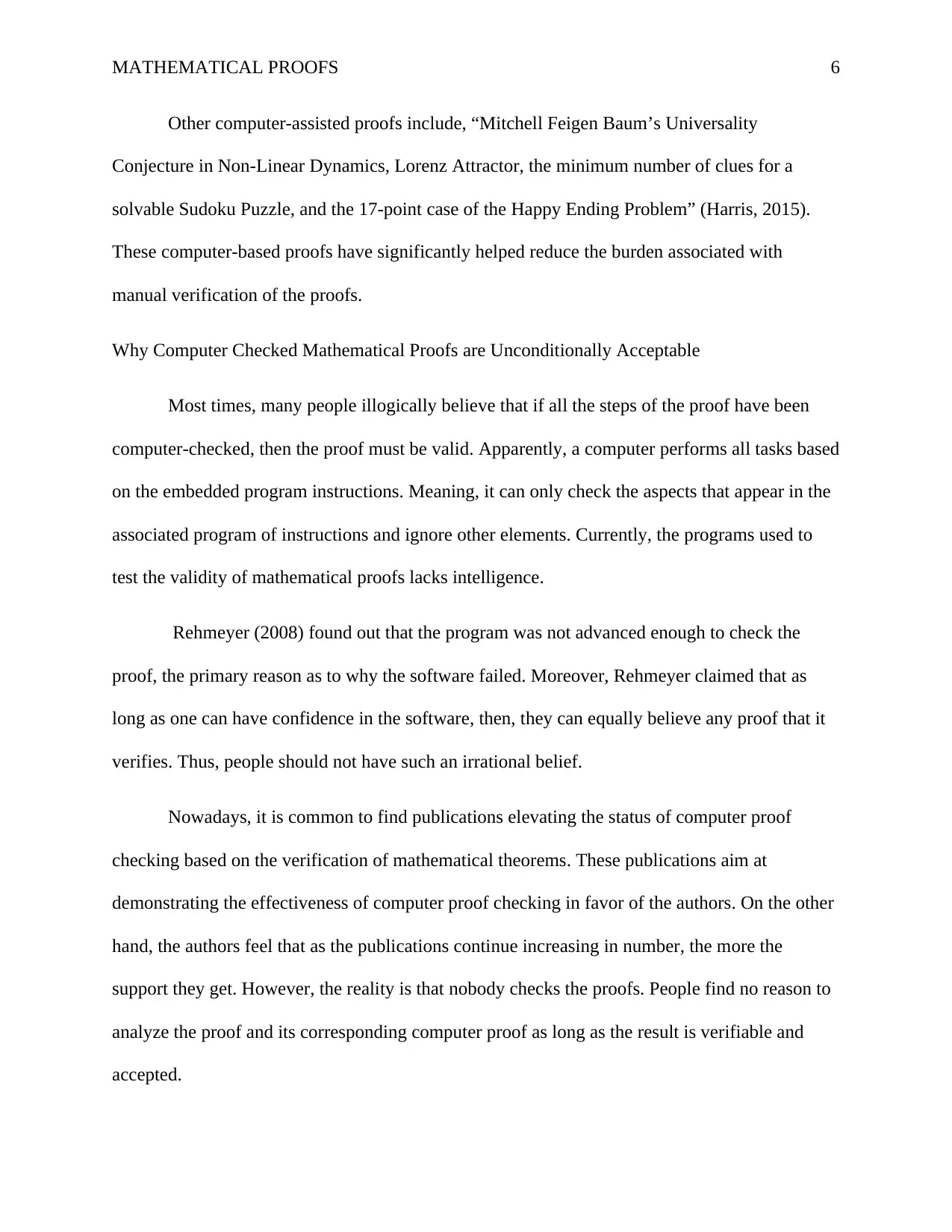
MATHEMATICAL PROOFS 6
Other computer-assisted proofs include, “Mitchell Feigen Baum’s Universality
Conjecture in Non-Linear Dynamics, Lorenz Attractor, the minimum number of clues for a
solvable Sudoku Puzzle, and the 17-point case of the Happy Ending Problem” (Harris, 2015).
These computer-based proofs have significantly helped reduce the burden associated with
manual verification of the proofs.
Why Computer Checked Mathematical Proofs are Unconditionally Acceptable
Most times, many people illogically believe that if all the steps of the proof have been
computer-checked, then the proof must be valid. Apparently, a computer performs all tasks based
on the embedded program instructions. Meaning, it can only check the aspects that appear in the
associated program of instructions and ignore other elements. Currently, the programs used to
test the validity of mathematical proofs lacks intelligence.
Rehmeyer (2008) found out that the program was not advanced enough to check the
proof, the primary reason as to why the software failed. Moreover, Rehmeyer claimed that as
long as one can have confidence in the software, then, they can equally believe any proof that it
verifies. Thus, people should not have such an irrational belief.
Nowadays, it is common to find publications elevating the status of computer proof
checking based on the verification of mathematical theorems. These publications aim at
demonstrating the effectiveness of computer proof checking in favor of the authors. On the other
hand, the authors feel that as the publications continue increasing in number, the more the
support they get. However, the reality is that nobody checks the proofs. People find no reason to
analyze the proof and its corresponding computer proof as long as the result is verifiable and
accepted.
Other computer-assisted proofs include, “Mitchell Feigen Baum’s Universality
Conjecture in Non-Linear Dynamics, Lorenz Attractor, the minimum number of clues for a
solvable Sudoku Puzzle, and the 17-point case of the Happy Ending Problem” (Harris, 2015).
These computer-based proofs have significantly helped reduce the burden associated with
manual verification of the proofs.
Why Computer Checked Mathematical Proofs are Unconditionally Acceptable
Most times, many people illogically believe that if all the steps of the proof have been
computer-checked, then the proof must be valid. Apparently, a computer performs all tasks based
on the embedded program instructions. Meaning, it can only check the aspects that appear in the
associated program of instructions and ignore other elements. Currently, the programs used to
test the validity of mathematical proofs lacks intelligence.
Rehmeyer (2008) found out that the program was not advanced enough to check the
proof, the primary reason as to why the software failed. Moreover, Rehmeyer claimed that as
long as one can have confidence in the software, then, they can equally believe any proof that it
verifies. Thus, people should not have such an irrational belief.
Nowadays, it is common to find publications elevating the status of computer proof
checking based on the verification of mathematical theorems. These publications aim at
demonstrating the effectiveness of computer proof checking in favor of the authors. On the other
hand, the authors feel that as the publications continue increasing in number, the more the
support they get. However, the reality is that nobody checks the proofs. People find no reason to
analyze the proof and its corresponding computer proof as long as the result is verifiable and
accepted.
⊘ This is a preview!⊘
Do you want full access?
Subscribe today to unlock all pages.

Trusted by 1+ million students worldwide
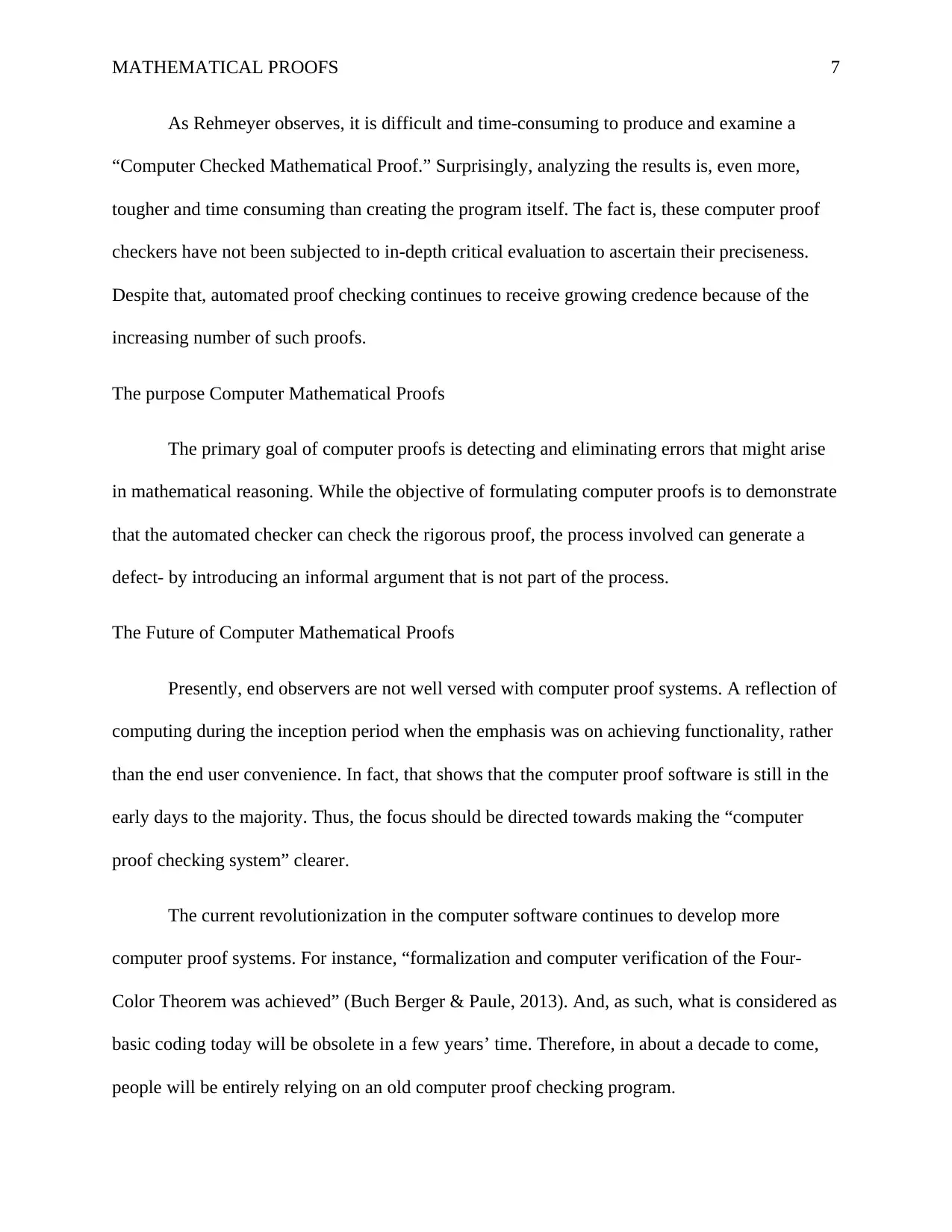
MATHEMATICAL PROOFS 7
As Rehmeyer observes, it is difficult and time-consuming to produce and examine a
“Computer Checked Mathematical Proof.” Surprisingly, analyzing the results is, even more,
tougher and time consuming than creating the program itself. The fact is, these computer proof
checkers have not been subjected to in-depth critical evaluation to ascertain their preciseness.
Despite that, automated proof checking continues to receive growing credence because of the
increasing number of such proofs.
The purpose Computer Mathematical Proofs
The primary goal of computer proofs is detecting and eliminating errors that might arise
in mathematical reasoning. While the objective of formulating computer proofs is to demonstrate
that the automated checker can check the rigorous proof, the process involved can generate a
defect- by introducing an informal argument that is not part of the process.
The Future of Computer Mathematical Proofs
Presently, end observers are not well versed with computer proof systems. A reflection of
computing during the inception period when the emphasis was on achieving functionality, rather
than the end user convenience. In fact, that shows that the computer proof software is still in the
early days to the majority. Thus, the focus should be directed towards making the “computer
proof checking system” clearer.
The current revolutionization in the computer software continues to develop more
computer proof systems. For instance, “formalization and computer verification of the Four-
Color Theorem was achieved” (Buch Berger & Paule, 2013). And, as such, what is considered as
basic coding today will be obsolete in a few years’ time. Therefore, in about a decade to come,
people will be entirely relying on an old computer proof checking program.
As Rehmeyer observes, it is difficult and time-consuming to produce and examine a
“Computer Checked Mathematical Proof.” Surprisingly, analyzing the results is, even more,
tougher and time consuming than creating the program itself. The fact is, these computer proof
checkers have not been subjected to in-depth critical evaluation to ascertain their preciseness.
Despite that, automated proof checking continues to receive growing credence because of the
increasing number of such proofs.
The purpose Computer Mathematical Proofs
The primary goal of computer proofs is detecting and eliminating errors that might arise
in mathematical reasoning. While the objective of formulating computer proofs is to demonstrate
that the automated checker can check the rigorous proof, the process involved can generate a
defect- by introducing an informal argument that is not part of the process.
The Future of Computer Mathematical Proofs
Presently, end observers are not well versed with computer proof systems. A reflection of
computing during the inception period when the emphasis was on achieving functionality, rather
than the end user convenience. In fact, that shows that the computer proof software is still in the
early days to the majority. Thus, the focus should be directed towards making the “computer
proof checking system” clearer.
The current revolutionization in the computer software continues to develop more
computer proof systems. For instance, “formalization and computer verification of the Four-
Color Theorem was achieved” (Buch Berger & Paule, 2013). And, as such, what is considered as
basic coding today will be obsolete in a few years’ time. Therefore, in about a decade to come,
people will be entirely relying on an old computer proof checking program.
Paraphrase This Document
Need a fresh take? Get an instant paraphrase of this document with our AI Paraphraser
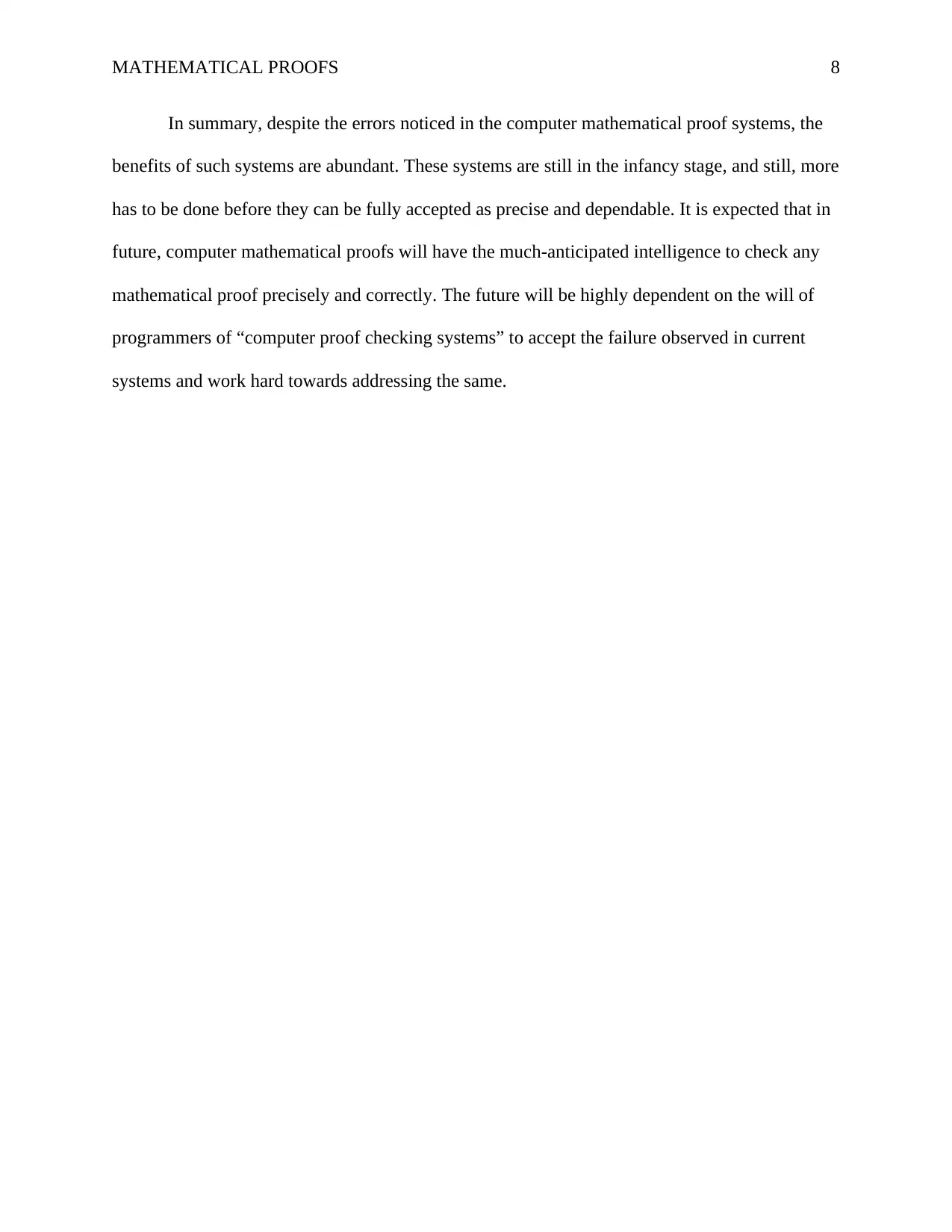
MATHEMATICAL PROOFS 8
In summary, despite the errors noticed in the computer mathematical proof systems, the
benefits of such systems are abundant. These systems are still in the infancy stage, and still, more
has to be done before they can be fully accepted as precise and dependable. It is expected that in
future, computer mathematical proofs will have the much-anticipated intelligence to check any
mathematical proof precisely and correctly. The future will be highly dependent on the will of
programmers of “computer proof checking systems” to accept the failure observed in current
systems and work hard towards addressing the same.
In summary, despite the errors noticed in the computer mathematical proof systems, the
benefits of such systems are abundant. These systems are still in the infancy stage, and still, more
has to be done before they can be fully accepted as precise and dependable. It is expected that in
future, computer mathematical proofs will have the much-anticipated intelligence to check any
mathematical proof precisely and correctly. The future will be highly dependent on the will of
programmers of “computer proof checking systems” to accept the failure observed in current
systems and work hard towards addressing the same.
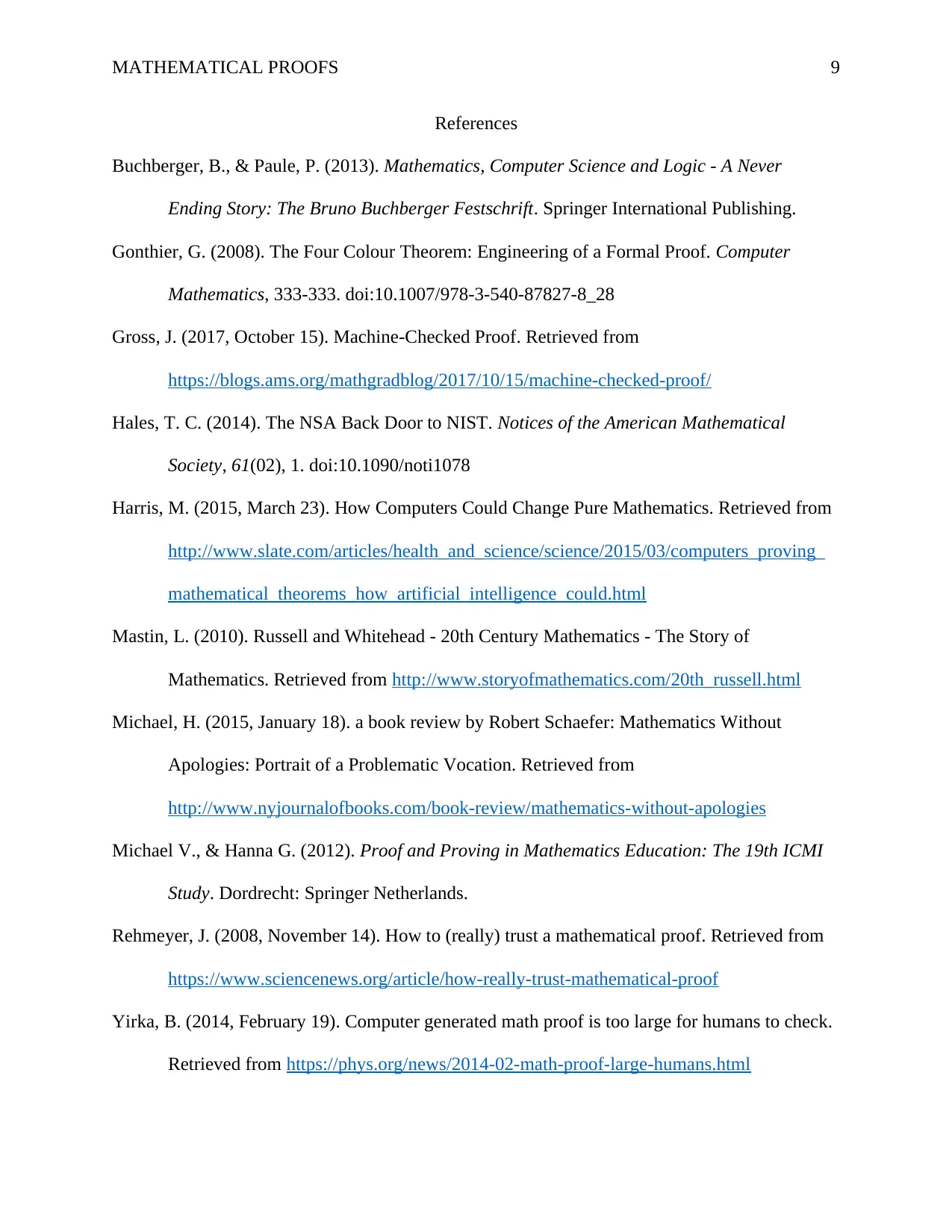
MATHEMATICAL PROOFS 9
References
Buchberger, B., & Paule, P. (2013). Mathematics, Computer Science and Logic - A Never
Ending Story: The Bruno Buchberger Festschrift. Springer International Publishing.
Gonthier, G. (2008). The Four Colour Theorem: Engineering of a Formal Proof. Computer
Mathematics, 333-333. doi:10.1007/978-3-540-87827-8_28
Gross, J. (2017, October 15). Machine-Checked Proof. Retrieved from
https://blogs.ams.org/mathgradblog/2017/10/15/machine-checked-proof/
Hales, T. C. (2014). The NSA Back Door to NIST. Notices of the American Mathematical
Society, 61(02), 1. doi:10.1090/noti1078
Harris, M. (2015, March 23). How Computers Could Change Pure Mathematics. Retrieved from
http://www.slate.com/articles/health_and_science/science/2015/03/computers_proving_
mathematical_theorems_how_artificial_intelligence_could.html
Mastin, L. (2010). Russell and Whitehead - 20th Century Mathematics - The Story of
Mathematics. Retrieved from http://www.storyofmathematics.com/20th_russell.html
Michael, H. (2015, January 18). a book review by Robert Schaefer: Mathematics Without
Apologies: Portrait of a Problematic Vocation. Retrieved from
http://www.nyjournalofbooks.com/book-review/mathematics-without-apologies
Michael V., & Hanna G. (2012). Proof and Proving in Mathematics Education: The 19th ICMI
Study. Dordrecht: Springer Netherlands.
Rehmeyer, J. (2008, November 14). How to (really) trust a mathematical proof. Retrieved from
https://www.sciencenews.org/article/how-really-trust-mathematical-proof
Yirka, B. (2014, February 19). Computer generated math proof is too large for humans to check.
Retrieved from https://phys.org/news/2014-02-math-proof-large-humans.html
References
Buchberger, B., & Paule, P. (2013). Mathematics, Computer Science and Logic - A Never
Ending Story: The Bruno Buchberger Festschrift. Springer International Publishing.
Gonthier, G. (2008). The Four Colour Theorem: Engineering of a Formal Proof. Computer
Mathematics, 333-333. doi:10.1007/978-3-540-87827-8_28
Gross, J. (2017, October 15). Machine-Checked Proof. Retrieved from
https://blogs.ams.org/mathgradblog/2017/10/15/machine-checked-proof/
Hales, T. C. (2014). The NSA Back Door to NIST. Notices of the American Mathematical
Society, 61(02), 1. doi:10.1090/noti1078
Harris, M. (2015, March 23). How Computers Could Change Pure Mathematics. Retrieved from
http://www.slate.com/articles/health_and_science/science/2015/03/computers_proving_
mathematical_theorems_how_artificial_intelligence_could.html
Mastin, L. (2010). Russell and Whitehead - 20th Century Mathematics - The Story of
Mathematics. Retrieved from http://www.storyofmathematics.com/20th_russell.html
Michael, H. (2015, January 18). a book review by Robert Schaefer: Mathematics Without
Apologies: Portrait of a Problematic Vocation. Retrieved from
http://www.nyjournalofbooks.com/book-review/mathematics-without-apologies
Michael V., & Hanna G. (2012). Proof and Proving in Mathematics Education: The 19th ICMI
Study. Dordrecht: Springer Netherlands.
Rehmeyer, J. (2008, November 14). How to (really) trust a mathematical proof. Retrieved from
https://www.sciencenews.org/article/how-really-trust-mathematical-proof
Yirka, B. (2014, February 19). Computer generated math proof is too large for humans to check.
Retrieved from https://phys.org/news/2014-02-math-proof-large-humans.html
⊘ This is a preview!⊘
Do you want full access?
Subscribe today to unlock all pages.

Trusted by 1+ million students worldwide
1 out of 9
Your All-in-One AI-Powered Toolkit for Academic Success.
+13062052269
info@desklib.com
Available 24*7 on WhatsApp / Email
![[object Object]](/_next/static/media/star-bottom.7253800d.svg)
Unlock your academic potential
Copyright © 2020–2025 A2Z Services. All Rights Reserved. Developed and managed by ZUCOL.